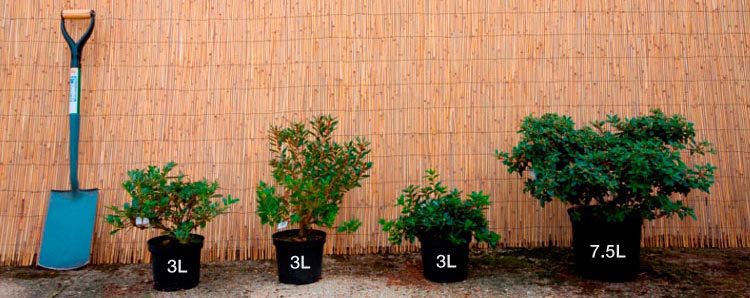Natural Pest & Disease Control 750ml
Item: XSNATPD
 Currently Unavailable
Currently Unavailable
Collect in Store
This item is available for collection.
Home Delivery
UK mainland delivery from £8.95
Nature's Answer to pest and disease control, with a sulphur and fatty acid base to reduce powdery mildew, and control whitefly, greenfly, spider mite and thrips. Read the label. Apply as directed.
Good to know
We aim to offer an interesting range of sundries to ensure that your chosen plants get off to the best possible start in your garden. Plant them properly with the right products, and they will reward you well for years to come! Add some of these essentials when you place your order.
Composts - Excellent quality and value. A far better professional quality compost than anything offered by the main garden compost suppliers. Our compost has proper aeration and drainage, and is not milled to dust like so many other composts
Fertilizer - We tried the lot, and now we have commissioned our own slow-release fertilizer which we use on the nursery with great results, as it has all the right ingredients for ericaceous plants! We also offer a range of ‘curative’ fertilizers to correct deficiencie
Natural tonics and controls - We have sourced some really good professional grade organic products that work, and that we use on our nursery with good results. These help to keep your plants in tip-top condition.
Tools - Everyone needs a new pair of gloves, secateurs and some good tools from time to time. We list some quality products at a good price.
For further advice, For further advice, see here
The Basics
Ideal soil
Acidic soil, good organic content, pH 4.5-6.0. Inkarho range of rhododendrons will tolerate soils up to pH7.5
Sun or Shade
Light dappled shade is best for most varieties.
Shelter
Refer to hardiness rating. Give young plants protection.
Site Selection
Avoid close to trees, roots, invasive weeds, walls, hot patios, dry banks and waterlogged soils. Do not use weed matting or stone mulch.
Plant spacing
Use the height shown in 10 years as a guide to the distance between each plant. Allow room for plant to fill out. If planting closer for instant impact, be prepared to move plants after a few years.
Compost
- 3 litre pot, dig in 10-20 litres of ericaceous compost.
- 7.5 litre pot, dig in 20-30 litres of ericaceous compost.
- 70-80cm specimen, dig in 60 litres of ericaceous compost.
- 100-120cm specimen, dig in 120 litres of ericaceous compost.
Planting depth
Plant high in the ground, with the top of the rootball visible.
Feeding
Slow-release ericaceous feed recommended in March and straight after flowering.
Mulch
Recommended every few years.
Water
The key ingredient! Keep moist all season, especially the critical time at end of June for flower bud initiation. Tap water is better than no water. Heavy dose at least once per week in dry weather.
Drainage
Ensure good drainage in winter, especially with yellow flowering varieties. Avoid waterlogged sites.
Pruning
Rhododendrons and Camellias: Not normally required. Tidy wayward shoots after flowering.
Evergreen azaleas and Bloombux can be clipped into a low hedge.
Magnolias and Acers: Formative pruning when young to shape into a tree or bush.
Deadheading
Remove old flower-heads, particularly on young or weak plants.
For further advice see here
Size Guide

Delivery & Returns
Our website calculates the delivery charge according to weight and delivery location throughout the UK. To see these charges, please enter your postcode at the checkout, and you will see the charge vary as you add more items to your wheelbarrow.
 Millais Nurseries
Millais Nurseries



